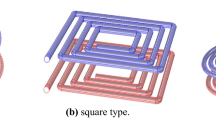Abstract
Wireless power transfer via magnetic resonant coupling is widely researched for various applications especially for charging electric vehicles. In order to reduce the dependency on battery capacity, charging while the vehicle is moving may be a solution. Wireless power transfer lane is constructed by embedding the coils beneath the road to provide charging coverage to certain distance. The actual system will consists of arbitrary number of coils and therefore conventional equivalent circuit analysis will be complex. In this paper, a new and simplified analysis method using impedance inverter representation and power division principle is proposed to investigate the feasibility of charging lane.




















Similar content being viewed by others


References
Imura, T., Uchida, T., Hori, Y.: Flexibility of contactless power transfer using magnetic resonance coupling to air gap and misalignment for EV. World Electr. Veh. J. 3(2009), 24–34 (2009)
Kim, J.W., et al.: Wireless power transfer for free positioning using compact planar multiple self-resonators, 2012 IEEE MTT-S Int. Microwave Workshop Series on Innovative Wireless Power Transmission: Technologies, Systems, and Applications (IMWS), pp. 127–130 (2012)
Cannon, B.L, Hoburg, J.F., Stancil, D.D., Goldstein, S.C.: Magnetic resonant coupling as a potential means for wireless power transfer to multiple small receivers. IEEE Trans. Power Electron 24(7), 1819–1825 (2009)
Dionigi, M., Mongiardo, M.: CAD of efficient wireless power transmission systems. IEEE MTT-S Int. Microwave Symp. Dig. (MTT), 1–4 (2011)
Koh, K.E., Beh, T.C., Imura, T., Hori, Y.: Impedance matching and power division using impedance inverter for wireless power transfer via magnetic resonant coupling. IEEE Trans. Ind. Appl. 50(3), 2061–2070 (2014)
Yilmaz, M., Buyukdegirmenci, V.T., Krein, P.T.: General design requirements and analysis of roadbed inductive power transfer system for dynamic electric vehicle charging, IEEE Transportation Electrification Conference and Expo (ITEC) (2012)
Imura, T.: Equivalent circuits for repeater antennas used in wireless power transfer via magnetic resonance coupling. Elect. Eng. Jpn. 183, 51–62 (2013). doi:10.1002/eej.22360
Low, Z.N., Casanova, J.J., Lin, J.: A loosely coupled planar wireless power transfer system supporting multiple receivers. Adv. Power Electron 2010, 1–13 (2010)
Ma, C., Zhu, X., Fu, M.: Wireless charging of electric vehicles: A Review and Experiments, in ASME 2011 Int. Design Engineering Technical Conferences and Computers and Information in Engineering Conf., pp. 881-887
Yokoi, Y., Taniya, A., Horiuchi, M., Kobayashi, S.: Developement of KW class wireless power transmission system for EV using magnetic resonant method, presented at 1st Int. Electric Vehicle Technology Conference, Yokohama, Japan (2011)
Matthaei, G.L., Young, L., Jones, E.M.T. Microwave Filters, Impedance Matching Networks and Coupling Structures. Artech House, Norwood, MA (1980)
Collin, R.E.: Foundations for Microwave Engineering. 2nd. John Wiley and Sons, Inc., NJ (2001)
Koh, K.E., Beh, T.C., Imura, T., Hori, Y.: Multi-receiver and repeater wireless power transfer via magnetic resonance coupling – impedance matching and power division utilizing impedance inverter, The 15th Int. Conf., on Electrical Machines and Systems (ICEMS2012) (2012)
Karalis, A., Joannopoulos, J.D., Soljaicic, M.: Efficient Wireless Non- Radiative Mid-Range Energy Transfer. Ann. Phys. 323(1), 34–38 (2008). doi10.1016/j.aop.2007.04.017.
Agilent Technologies: Agilent E5061B Network Analyzer Help. Version 2.0. Agilent Techonologies (2010)
Author information
Authors and Affiliations
Corresponding author
Rights and permissions
About this article
Cite this article
Koh, K.E., Imura, T. & Hori, Y. Analysis of Dead Zone in Wireless Power Transfer via Magnetic Resonant Coupling for Charging Moving Electric Vehicles. Int. J. ITS Res. 14, 152–163 (2016). https://doi.org/10.1007/s13177-015-0110-y
Received:
Revised:
Accepted:
Published:
Issue Date:
DOI: https://doi.org/10.1007/s13177-015-0110-y


